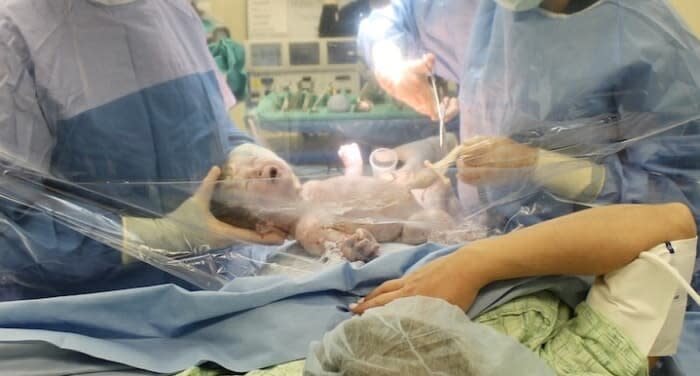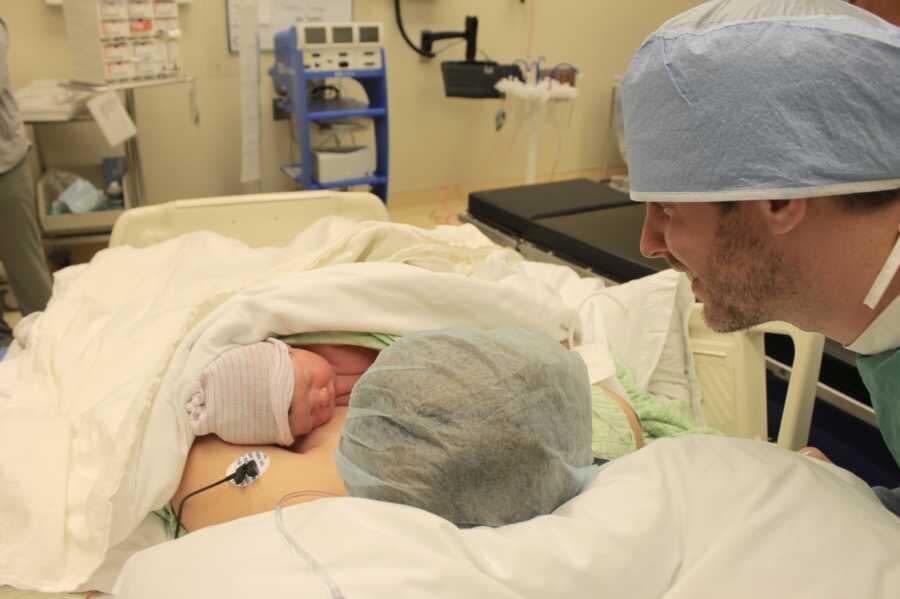How Clear C-Section Drapes Let Moms Meet Their Babies in a New Way

Tracy Abney Photography
Last year, photos of a mom named Allison giving birth, taken by doula and photographer Tracy Abney, went wildly viral. The reason: Abney's images illustrated how incredibly heartwarming it can be for new parents to welcome their newborn in a clear drape, or window, caesarean section. The trend is considered one element of a "gentle" C-section, in which bonding with the baby takes a higher priority, as long as both the birthing parent and baby are doing well, a mom's arms aren't strapped down, the team allows immediate skin-to-skin, if possible, and a new mom can breastfeed in the OR or recovery room, Abney explains.
This version of the procedure marks "a change in the attitudes toward C-sections, where the care team—the obstetrician, anesthesiologist, and nurses—aims to make the C-section experience in the operating room as similar as possible to the labor and delivery room," notes David Garfinkel, M.D., attending physician at Morristown Medical Center, and senior partner at One to One FemaleCare, in New Jersey. "A gentle C-section allows a woman to be almost as involved as if her birth was happening vaginally."
G. Thomas Ruiz, M.D., OB-GYN Lead at MemorialCare Orange Coast Medical Center in Fountain Valley, California, agrees that conventional C-sections might make it tougher for parents to be involved and attain a certain level of intimacy. "When we do C-sections, they're usually draped, and we create a sterile field," Dr. Ruiz explains. But C-sections that use a clear drape can be a game-changer, because it allows the mom to witness the birth.
The option to go this route while welcoming a child via C-section has become increasingly buzz-worthy. Here's what expectant parents need to know about the option.
RELATED: Why You Might Need a C-Section
What does a clear drape C-section entail?
As Dr. Ruiz noted, a typical C-section involves a solid drape that prevents a mom and her partner from seeing past her bra-line, or just below the breasts. But with a clear drape section, there's an opaque portion and a clear portion.
Abney concurs, sharing, "The opaque drape is either clipped or Velcro-ed to the clear drape. The initials cuts are performed with the opaque drape in place."
But just before the baby's born, [the doctor] can drop the solid portion of drape, so parents can actually look through the clear plastic drape and see the baby delivered, Dr. Ruiz explains.
Squeamish about taking in your incision site? It's unlikely that you will, Abney notes. "I tell my clients to imagine laying down flat on their bed and ask them if they can see down to their pubic bone," she says. "Most pregnant women cannot. Then, add in an opaque drape that is often pooled on top of the breasts, and you really can't see to where the incision is."

Why might parents want to do a clear drape C-section?
Given that cesarean deliveries by maternal request only account for 2.5 percent of births in the U.S., most women who have C-sections weren't planning on it. And many who do undergo C-sections "were expecting to witness a vaginal delivery where you can see everything going on," Dr. Ruiz says. It's for this reason that using a clear drape might offer an emotional benefit for a mom. "It keeps them a little more involved and engaged in the delivery process," Dr. Ruiz notes.
Abney can personally attest to the need for an option like a clear drape. "When I had my C-section—and many of my clients have said the same—I felt very disconnected from the birth," she notes. "Everyone saw my daughter before I did. I could hear her, but not see her. I didn't see her until she was cleaned up and wrapped in a blanket, then she was taken away and I didn't see her for a long time. Clear drapes help the mother feel like she is part of the birthing process. She can see her baby before it is taken to the warmer. She can see the baby when everyone else does, the moment the baby is born. She can match the sound of the baby's cries while watching the quiver of the baby's little chin."
RELATED: How Many C-Sections Can You Have?
How might a clear drape change the procedure?
In addition to allowing a mom to be more involved in her C-section, the window gives the mother an early bonding opportunity with her baby that she would get immediately during a vaginal delivery but not as immediate with a conventional section, notes Linda Dudas, MSN, RNC, CNL, Unit Director Obstetric Specialties at UPMC Magee-Womens Hospital in Pittsburgh, Pennsylvania.
While Dudas says there really is not a downside to using the window, it is possible that "the patient or her support person may get uncomfortable with seeing the baby right at delivery, as they are wet, and [there is] lots of vernix and blood on the baby," and it "may cause fainting."
In the end, most hospitals that offer the option leave it up to the expectant parents to decide if it's right for them. "For the most part, the patients seem to like the experience," Dudas says. "We leave the option of utilizing the drape completely up to the patients."
If you're interested in using a clear drape, or window, should you end up having a C-section, Dr. Ruiz recommends discussing it with your OB-GYN and birth team ahead of time and making it part of your birth plan.

